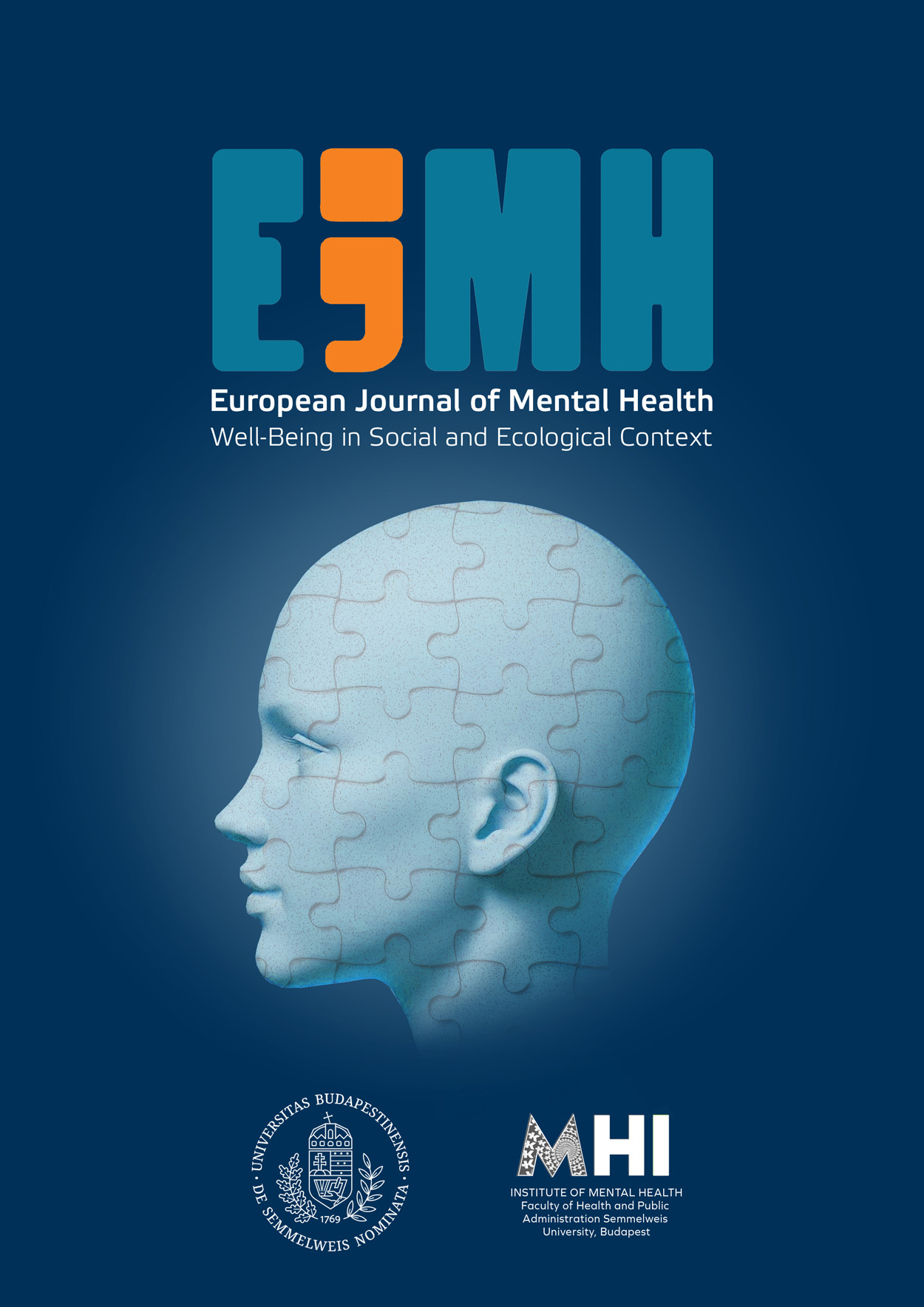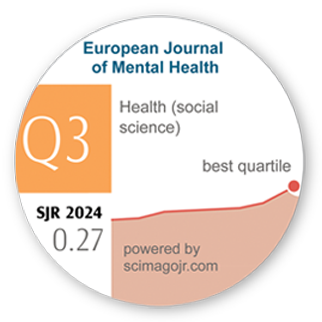Emotional Awareness and Internalizing Problems. A Preliminary Test of State and Trait Associations among Adolescents
DOI:
https://doi.org/10.5708/EJMH.18.2023.0007Keywords:
levels of emotional awareness, internalizing problems, state-trait differences, early developmental environmentAbstract
Introduction: Difficulties in emotional awareness (EA) are often linked to the risk of internalizing problems (IP). Most empirical studies have found this association but have not considered possible state- and trait-related fluctuations in EA and IP assessments.
Aims: We tested the directionality of the state-level associations, that is, whether EA at Time 1 predicts IP at Time 2 or the other way around. In line with previous research, we hypothesized that low EA would predict a subsequent increase in IP, as difficulties in emotional awareness dispose one to emotional problems. As an alternative model, we tested the trait-level associations between EA and IP. We hypothesized that a negative latent correlation exists between EA and IP, as common factors may cause them to be associated at the trait level.
Methods: Participants were 68 students who completed the Levels of Emotional Awareness Scale and the Strength and Difficulties Questionnaire at two-time points with a one-month interval. We used the Cross-lagged Panel Model to test the state-level associations and structural equation modeling to test trait-level effects.
Results: Results displayed no directional effect of EA on IP, and neither did IP predict EA within one month. However, we found a trait-level correlation between EA and IP. We discuss the preliminary results between state and trait level EA and IP in the context of the early developmental environment.
Conclusions: This study is a preliminary test of state- and trait-level associations between EA and IP, which could be valuable for practitioners and clinicians.
References
Alloy, L. B., Wagner, C. A., Black, S. K., Gerstein, R. K., & Abramson, L.Y. (2010). The breakdown of self-enhancement and self-protection in depression. In M. Alicke & C. Sedikides (Eds.), The handbook of self-enhancement and self-protection (pp. 358–379). Guildford.
Bajgar, J., Ciarrochi, J., Lane, R., & Deane, F. P. (2005). Development of the Levels of Emotional Awareness Scale for Children (LEAS-C). British Journal of Developmental Psychology, 23(4), 569–586.
https://doi.org/10.1348/026151005X35417
Blöte, A. W., & Westenberg, P. M. (2019). The temporal association between emotional clarity and depression symptoms in adolescents. Journal of Adolescence, 71(1), 110–118.
https://doi.org/10.1016/j.adolescence.2019.01.005
Boden, M. T., & Thompson, R. J. (2017). Meta-analysis of the association between emotional clarity and attention to emotions. Emotion Review, 9(1), 79–85.
https://doi.org/10.1177/1754073915610640
Bonanno, G. A., Papa, A., Lalande, K., Westphal, M., & Coifman, K. (2004). The importance of being flexible: The ability to both enhance and suppress emotional expression predicts long-term adjustment. Psychological Science, 15(7), 482–487.
https://doi.org/10.1111/j.0956-7976.2004.00705.x
Dykas, M. J., & Cassidy, J. (2011). Attachment and the processing of social information across the life span: Theory and evidence. Psychological Bulletin, 137(1), 19–46.
https://doi.org/10.1037/a0021367
Finney, S. J., & DiStefano, C. (2006). Non-normal and categorical data in structural equation modeling. In G. Hancock & R. Mueller (Eds.), Structural Equation Modeling: A Second Course (pp. 269–314). Information Age Publishing.
Fivush, R., & Sales, J. M. (2006). Coping, attachment, and mother-child narratives of stressful events. Merrill-Palmer Quarterly, (52)1, 125–150. https://doi.org/10.1353/mpq.2006.0003
Flynn, M., & Rudolph, K. D. (2010). The contribution of deficits in emotional clarity to stress responses and depression. Journal of Applied Developmental Psychology, 31(4), 291–297.
https://doi.org/10.1016/j.appdev.2010.04.004
Flynn, M., & Rudolph, K. D. (2014). A prospective examination of emotional clarity, stress responses, and depressive symptoms during early adolescence. The Journal of Early Adolescence, 34(7), 923–939.
https://doi.org/10.1177/0272431613513959
Gasper, K., & Clore, G. L. (1998). The persistent use of negative affect by anxious individuals to estimate risk. Journal of Personality and Social Psychology, 74(5), 1350–1363.
https://doi.org/10.1037/0022-3514.74.5.1350
Ghafaryan Shirazi, Y., Punamäki, R.-L., Peltonen, K., Malekzadeh, M., & Esmaeili, O. (2021). Narrative-based intervention and emotional intelligence in female children. East European Journal of Psycholinguistics, 8(1), 95–109.
https://doi.org/10.29038/eejpl.2021.8.1.shi
Goodman, R. (2001). Psychometric properties of the strengths and difficulties questionnaire. Journal of the American Academy of Child and Adolescent Psychiatry, 40(11), 1337–1345.
https://doi.org/10.1097/00004583-200111000-00015
Goodman, A., Lamping, D. L., & Ploubidis, G. B. (2010) When to use broader internalizing an externalizing subscales instead of the hypothesized five subscales on the Strengths and Difficulties Questionnaire (SDQ): Data from British parents, teachers and children. Journal of Abnormal Child Psychology, 38(8), 1179–1191.
https://doi.org/10.1007/s10802-010-9434-x
Goodman R. (1997). The Strengths and Difficulties Questionnaire: A research note. Journal of Child Psychology and Psychiatry, 38(5), 581–586.
https://doi.org/10.1111/j.1469-7610.1997.tb01545.x
Gottman, J. M., Katz, L. F., & Hooven, C. (1996). Parental meta-emotion philosophy and the emotional life of families: Theoretical models and preliminary data. Journal of Family Psychology, 10(3), 243–268.
https://doi.org/10.1037/0893-3200.10.3.243
Gross, J. J., & Jazaieri, H. (2014). Emotion, emotion regulation, and psychopathology: An affective science perspective. Clinical Psychological Science, 2(4), 387–401.
https://doi.org/10.1177/2167702614536164
Hair, J., Black, W., Babin, B., & Anderson, R. (2014). Multivariate data analysis (7th ed.). Pearson Education Limited.
Hu, L., & Bentler, P. M. (1999). Cutoff criteria for fit indexes in covariance structure analysis: Conventional criteria versus new alternatives. Structural Equation Modeling: A Multidisciplinary Journal, 6(1), 1–55.
https://doi.org/10.1080/10705519909540118
Hamaker, E. L., Kuiper, R. M., & Grasman, R. P. (2015). A critique of the cross-lagged panel model. Psychological Methods, 20(1), 102–116.
https://doi.org/10.1037/a0038889
Laible, D. (2004a). Mother–child discourse in two contexts: Links with child temperament, attachment security, and socioemotional competence. Developmental Psychology, 40(6), 979–992.
https://doi.org/10.1037/0012-1649.40.6.979
Laible, D. (2004b). Mother–child discourse surrounding a child's past behavior at 30-months: Links to emotional understanding and early conscience development at 36 months. Merrill-Palmer Quarterly, 50(2), 159–180.
https://doi.org/10.1353/mpq.2004.0013
Lane, R. D. (2000). Levels of emotional awareness: Neurological, psychological, and social perspectives. In R. Bar-On & J. D. A. Parker (Eds.), The handbook of emotional intelligence: Theory, development, assessment, and application at home, school, and in the workplace (pp. 171–191). Jossey-Bass.
Lane, R. D. (2020). The construction of emotional experience: State‐related emotional awareness and its application to psychotherapy research and practice. Counselling and Psychotherapy Research, 20(3), 479–487.
https://doi.org/10.1002/capr.12331
Lane, R. D., & Schwartz, G. E. (1987). Levels of emotional awareness: A cognitive-developmental theory and its application to psychopathology. American Journal of Psychiatry, 144(2), 133–143.
https://doi.org/10.1176/ajp.144.2.133
Main, M., Kaplan, N., & Cassidy, J. (1985). Security in infancy, childhood, and adulthood: A move to the level of representation. Monographs of the Society for Research in Child Development, 50(1–2), 66–104.
https://doi.org/10.2307/3333827
Mayer, J. D., Salovey, P., Caruso, D. R., & Sitarenios, G. (2003). Measuring emotional intelligence with the MSCEIT V2.0. Emotion, 3(1), 97–105.
https://doi.org/10.1037/1528-3542.3.1.97
McLaughlin, K. A., Hatzenbuehler, M. L., Mennin, D. S., & Nolen-Hoeksema, S. (2011). Emotion dysregulation and adolescent psychopathology: A prospective study. Behaviour Research and Therapy, 49(9), 544–554.
https://doi.org/10.1016/j.brat.2011.06.003
Mieloo, C., Raat, H., van Oort, F., Bevaart, F., Vogel, I., Donker, M., & Jansen, W. (2012). Validity and reliability of the strengths and difficulties questionnaire in 5-6 year olds: Differences by gender or by parental education? PLOS ONE, 7(5), Article e36805.
https://doi.org/10.1371/journal.pone.0036805
Mikulincer, M., & Shaver, P. R. (2016). Attachment in adulthood: Structure, dynamics, and change (2nd ed.). The Guilford Press.
Munafò, M. R., Clark, T. G., Moore, L. R., Payne, E., Walton, R., & Flint, J. (2003). Genetic polymorphisms and personality in healthy adults: A systematic review and meta-analysis. Molecular Psychiatry, 8, 471–484.
https://doi.org/10.1038/sj.mp.4001326
Rieffe, C., & De Rooij, M. (2012). The longitudinal relationship between emotion awareness and internalizing symptoms during late childhood. European Child & Adolescent Psychiatry, 21, 349–356.
https://doi.org/10.1007/s00787-012-0267-8
Rosseel, Y. (2012). Lavaan: An R package for structural equation modeling. Journal of Statistical Software, 48(2), 1–36.
https://doi.org/10.18637/jss.v048.i02
Sendzik, L., Schäfer, J. Ö., Samson, A. C., Naumann, E., & Tuschen-Caffier, B. (2017). Emotional awareness in depressive and anxiety symptoms in youth: A meta-analytic review. Journal of Youth and Adolescence, 46, 687–700.
https://doi.org/10.1176/ajp.144.2.133
Scherer, K. R. (2009). The dynamic architecture of emotion: Evidence for the component process model. Cognition and Emotion, 23(7), 1307–1351.
https://doi.org/10.1080/02699930902928969
Scherer, K. R., & Brosch, T. (2009). Culture-specific appraisal biases contribute to emotion dispositions. European Journal of Personality, 23(3), 265–288.
https://doi.org/10.1002/per.714
Scherer, K. R., & Ceschi, G. (2000). Criteria for emotion recognition from verbal and nonverbal expression: Studying baggage loss in the airport. Personality and Social Psychology Bulletin, 26(3), 327–339.
https://doi.org/10.1177/0146167200265006
Smith, R., Killgore, W. D. S., & Lane, R. D. (2018). The structure of emotional experience and its relation to trait emotional awareness: A theoretical review. Emotion, 18(5), 670–692.
https://doi.org/10.1037/emo0000376
Sloman, L., Farvolden, P., Gilbert, P., & Price, J. (2006). The interactive functioning of anxiety and depression in agonistic encounters and reconciliation. Journal of Affective Disorders, 90(2–3), 93–99.
https://doi.org/10.1016/j.jad.2005.12.001
Spear, L. P. (2009). The behavioral neuroscience of adolescence. W. W. Norton & Company.
Schwarz, N., & Clore, G. L. (1983). Mood, misattribution, and judgments of well-being: Informative and directive functions of affective states. Journal of Personality and Social Psychology, 45(3), 513–523.
https://doi.org/10.1037/0022-3514.45.3.513
Stange, J. P., Alloy, L. B., Flynn, M., & Abramson, L. Y. (2013). Negative inferential style, emotional clarity, and life stress: Integrating vulnerabilities to depression in adolescence. Journal of Clinical Child & Adolescent Psychology, 42(4), 508–518.
https://doi.org/10.1080/15374416.2012.743104
Stocker, C. M., Richmond, M. K., Rhoades, G. K., & Kiang, L. (2007). Family emotional processes and adolescents' adjustment. Social Development, 16(2), 310–325.
https://doi.org/10.1111/j.1467-9507.2007.00386.x
Subic-Wrana, C., Beutel, M. E., Brähler, E., Stöbel-Richter, Y., Knebel, A., Lane, R. D., & Wiltink, J. (2014). How is emotional awareness related to emotion regulation strategies and self-reported negative affect in the general population? PLOS ONE, 9(3), Article e91846.
https://doi.org/10.1371/journal.pone.0091846
Thompson, R. A. (2014). Socialization of emotion and emotion regulation in the family. In J. J. Gross (Ed.), Handbook of emotion regulation (pp. 173–186). The Guilford Press.
Versluis, A., Verkuil, B., Lane, R. D., Hagemann, D., Thayer, J. F., & Brosschot, J. F. (2018). Ecological momentary assessment of emotional awareness: Preliminary evaluation of psychometric properties. Current Psychology, 40, 1402–1410.
https://doi.org/10.1007/s12144-018-0074-6
Veirman, E., Brouwers, S. A., & Fontaine, J. R. J. (2011). The assessment of emotional awareness in children: Validation of the Levels of Emotional Awareness Scale for Children. European Journal of Psychological Assessment, 27(4), 265–273.
https://doi.org/10.1027/1015-5759/a000073
Yao, S., Zhang, C., Zhu, X., Jing, X., McWhinnie, C. M., & Abela, J. R. Z. (2009). Measuring adolescent psychopathology: Psychometric properties of the self-report strengths and difficulties questionnaire in a sample of Chinese adolescents. Journal of Adolescent Health, 45(1), 55–62.
https://doi.org/10.1016/j.jadohealth.2008.11.006
Yap, M. B. H., & Jorm, A. F. (2015). Parental factors associated with childhood anxiety, depression, and internalizing problems: A systematic review and meta-analysis. Journal of Affective Disorders, 175, 424–440.
https://doi.org/10.1016/j.jad.2015.01.050
Yap, M. B. H., Pilkington, P. D., Ryan, S. M., & Jorm, A. F. (2014). Parental factors associated
with depression and anxiety in young people: A systematic review and meta-analysis. Journal of Affective Disorders, 156, 8–23.
https://doi.org/10.1016/j.jad.2013.11.007






